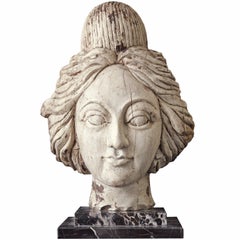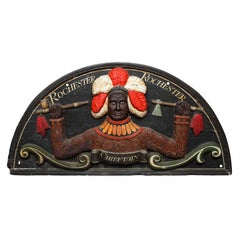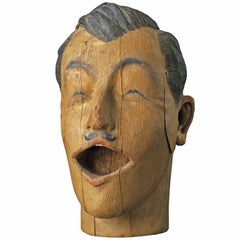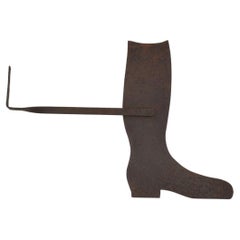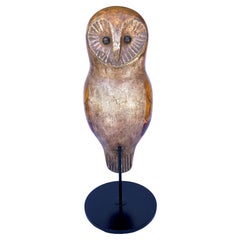Americana and Folk Art Antiques and Collectibles
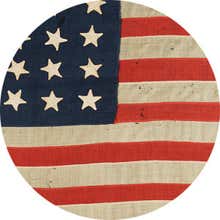
Though the pieces are timeless, folk art emerged as a collecting genre only in the 1920s. Then as now, collectors focused on American artifacts. The earliest were prompted in part by the awareness of a nation changed: in that decade, for the first time the majority of U.S. citizens lived in cities, rather than on farms and in small towns. At the same time, the ascendance of modernism in art and design was countered by promoters of the Colonial Revival style. That movement drew from attics and barns old hand-carved furniture, stilted 19th-century family portraits, weathervanes and butter churns.
The best folk art items were purchased by an odd mix that included bohemians and intellectuals, along with J.P. Morgan and members of the Chrysler and Rockefeller families (who began funding, for instance, the restoration of Colonial Williamsburg in Virginia in the 1920s). If nostalgia played a role, the primary motivation for folk art collectors was — as it is today — a recognition of the artistic merit and cultural significance of pure, honest expressions of the human impulse toward beauty.
Simplicity is its hallmark, yet folk art defies a simple definition — and covers a vast amount of ground. Folk art has been called "the art of the everyday": objects created by people, with no formal training in the arts, for use in their daily lives. These include everything from tools and toys to quilts, baskets, jugs, dowry chests and duck decoys. Folk art is generally made by hand; works might be carved, sewn, chiseled, knitted, hammered, woven or embroidered and more. Such techniques were passed down through the generations — one reason folk-art collecting has been described as "a kind of archaeology." Folk art reveals the inherent values and traditions of a community, through time-honored crafts, decorative motifs and pictorial subject matter.
All folk art intrinsically reflects a sense of pride. "Americana" is folk art that does so overtly: through work that honors civic ideals and celebrates national and local achievements. Americana includes flags, bunting, carved bald eagles, and needlework with allegorical figures representing Liberty and Democracy; or helmets and buckets used by a volunteer fire brigade; or the trappings of fraternal organizations such as the Oddfellows. Collectors of Americana typically also collect American antique furniture that, while made in the workshops of a master cabinetmaker or joiner, reflects regional stylistic traits, tastes and quirks.
Almost all folk art is anonymous — and the prominent exception being signed work by early 19th-century itinerant portrait artists like the New Englander Ammi Phillips, whose 1835 portrait of a young girl and her pets was the first piece of folk art to sell for $1 million at auction. Until relatively recently, work by Phillips and his ilk was the prime focus of folk art collectors: the folk art of the Northeast defined the category. But recently, more attention and more scholarship have been devoted to the folk art of other regions: to the South, and the artwork of enslaved African Americans and their descendants; and to the Southwestern and early Latino folk art. Born in a time of change, folk art collecting is changing along with the nation.
19th Century American Folk Art Antique Americana and Folk Art Antiques and Collectibles
Wood
19th Century American Folk Art Antique Americana and Folk Art Antiques and Collectibles
Wood
19th Century American Folk Art Antique Americana and Folk Art Antiques and Collectibles
Wood
19th Century American Antique Americana and Folk Art Antiques and Collectibles
Bronze
19th Century British Folk Art Antique Americana and Folk Art Antiques and Collectibles
Wood
19th Century American Folk Art Antique Americana and Folk Art Antiques and Collectibles
Limestone
19th Century American Folk Art Antique Americana and Folk Art Antiques and Collectibles
Iron
19th Century American Folk Art Antique Americana and Folk Art Antiques and Collectibles
Wood
Early 20th Century American Folk Art Americana and Folk Art Antiques and Collectibles
Wood
19th Century French Folk Art Antique Americana and Folk Art Antiques and Collectibles
Iron
20th Century American Folk Art Americana and Folk Art Antiques and Collectibles
Wood
1940s American Folk Art Vintage Americana and Folk Art Antiques and Collectibles
Wood, Cork
Late 19th Century European Arts and Crafts Antique Americana and Folk Art Antiques and Collectibles
Brass, Metal
1940s American Art Deco Vintage Americana and Folk Art Antiques and Collectibles
Chrome, Steel, Aluminum
1960s French Art Deco Vintage Americana and Folk Art Antiques and Collectibles
Plaster
1960s French Art Deco Vintage Americana and Folk Art Antiques and Collectibles
Plaster
1970s American American Craftsman Vintage Americana and Folk Art Antiques and Collectibles
Glass
Mid-20th Century Folk Art Americana and Folk Art Antiques and Collectibles
Blown Glass, Art Glass
1960s English Folk Art Vintage Americana and Folk Art Antiques and Collectibles
Wood
Early 20th Century American Folk Art Americana and Folk Art Antiques and Collectibles
Canvas, Cotton, Wood
1890s French Napoleon III Antique Americana and Folk Art Antiques and Collectibles
Alabaster
Read More
He Wrote ‘Oedipus Rex,’ but Do You Know What He Looked Like?
The Greek tragedian is said to have been handsome in his day.
These Soft Sculptures Are Childhood Imaginary Friends Come to Life
Miami artist and designer Gabriela Noelle’s fantastical creations appeal to the Peter Pan in all of us.
Salvatori Commissioned Several Famous Architects to Create Miniature Homes in Stone
Gabriele Salvatori explains how the COVID lockdowns inspired his design company's latest collection, the Village.
Christopher Norman Is Turning the Cast-Off Urban Trees of Los Angeles into Art
With a World War II–era milling machine, the California artist crafts poetic, sculptural furniture pieces.
These Human-Size Ceramic Hares Evoke Serious Emotions
Swedish artist Margit Brundin's large anthropomorphic animal sculptures are on view for the first time in the United States at Dienst + Dotter Antikviteter, in New York.
Tour the Wabi-Sabi New York Apartment of Andrianna Shamaris
As her sun-filled home reveals, the furniture maker and dealer puts a contemporary spin on antiques from around the globe.
Vicente Wolf’s Tips for Finding — and Living with — Eastern Treasures
The A-list designer shares his expertise on choosing authentic objects and displaying them with style.
Rodrigo Rivero Lake’s Mexico City Showroom Is a Museum-Worthy Trove of Spanish Colonial and Asian Antiques
The dealer and curator has spent the past 50 years amassing a collection of exceptional art, furniture and architectural elements that trace the cultural influence of the Spanish empire from Europe to the Americas and beyond.
